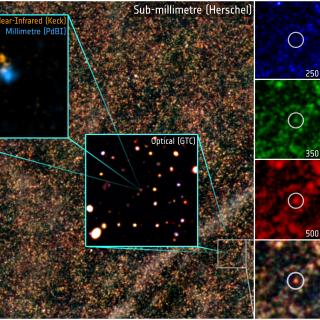Bibcode
Ismail, D.; Beelen, A.; Buat, V.; Berta, S.; Cox, P.; Stanley, F.; Young, A.; Jin, S.; Neri, R.; Bakx, T.; Dannerbauer, H.; Butler, K.; Cooray, A.; Nanni, A.; Omont, A.; Serjeant, S.; van der Werf, P.; Vlahakis, C.; Weiß, A.; Yang, C.; Baker, A. J.; Bendo, G.; Borsato, E.; Chartab, N.; Dye, S.; Eales, S.; Gavazzi, R.; Hughes, D.; Ivison, R.; Jones, B. M.; Krips, M.; Lehnert, M.; Marchetti, L.; Messias, H.; Negrello, M.; Perez-Fournon, I.; Riechers, D. A.; Urquhart, S.
Bibliographical reference
Astronomy and Astrophysics
Advertised on:
10
2023
Journal
Citations
20
Refereed citations
16
Description
We present the dust properties of 125 bright Herschel galaxies selected from the z-GAL NOEMA spectroscopic redshift survey. All the galaxies have precise spectroscopic redshifts in the range 1.3 < z < 5.4. The large instantaneous bandwidth of NOEMA provides an exquisite sampling of the underlying dust continuum emission at 2 and 3 mm in the observed frame, with flux densities in at least four sidebands for each source. Together with the available Herschel 250, 350, and 500 μm and SCUBA-2 850 μm flux densities, the spectral energy distribution (SED) of each source can be analyzed from the far-infrared to the millimeter, with a fine sampling of the Rayleigh-Jeans tail. This wealth of data provides a solid basis to derive robust dust properties, in particular the dust emissivity index (β) and the dust temperature (Tdust). In order to demonstrate our ability to constrain the dust properties, we used a flux-generated mock catalog and analyzed the results under the assumption of an optically thin and optically thick modified black body emission. The robustness of the SED sampling for the z-GAL sources is highlighted by the mock analysis that showed high accuracy in estimating the continuum dust properties. These findings provided the basis for our detailed analysis of the z-GAL continuum data. We report a range of dust emissivities with β ∼ 1.5 − 3 estimated up to high precision with relative uncertainties that vary in the range 7%−15%, and an average of 2.2 ± 0.3. We find dust temperatures varying from 20 to 50 K with an average of Tdust ∼ 30 K for the optically thin case and Tdust ∼ 38 K in the optically thick case. For all the sources, we estimate the dust masses and apparent infrared luminosities (based on the optically thin approach). An inverse correlation is found between Tdust and β with β ∝ Tdust−0.69, which is similar to what is seen in the local Universe. Finally, we report an increasing trend in the dust temperature as a function of redshift at a rate of 6.5 ± 0.5 K/z for this 500 μm-selected sample. Based on this study, future prospects are outlined to further explore the evolution of dust temperature across cosmic time.
Full Tables A.1 and B.1 are available at the CDS via anonymous ftp to cdsarc.cds.unistra.fr (ftp://130.79.128.5) or via https://cdsarc.cds.unistra.fr/viz-bin/cat/J/A+A/678/A27
Related projects

Formation and Evolution of Galaxies: Observations in Infrared and other Wavelengths
This IAC research group carries out several extragalactic projects in different spectral ranges, using space as well as ground-based telescopes, to study the cosmological evolution of galaxies and the origin of nuclear activity in active galaxies. The group is a member of the international consortium which built the SPIRE instrument for the
Ismael
Pérez Fournon

Molecular Gas and Dust in Galaxies Across Cosmic Time
Two of the most fundamental questions in astrophysics are the conversion of molecular gas into stars and how this physical process is a function of environments on all scales, ranging from planetary systems, stellar clusters, galaxies to galaxy clusters. The main goal of this internal project is to get insight into the formation and evolution of
Helmut
Dannerbauer